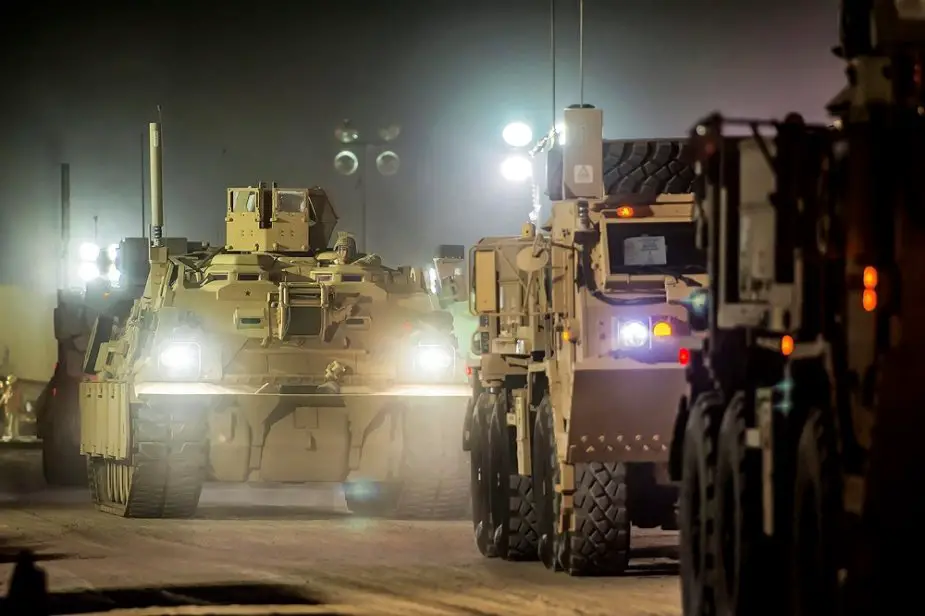Ensuring readiness for strategic support: U.S. Strategic Power Projection
The U.S. Army's ability to fight anywhere and at any time doesn't happen by chance. It is the result of reliable, agile and responsive logistics and sustainment capabilities, including Strategic Power Projection. Megan Cotton explains on U.S. Army’s website.

A convoy of vehicles drives through Army Prepositioned Stocks-5 remote staging lot in preparation for forward transport during a large-scale equipment issue from APS-5, at Camp Arifjan, Kuwait. APS-5 is managed and maintained by the 401st Army Field Support Brigade. (Picture source: Justin Graff)
That capability ensures that the Army can rapidly and efficiently support any mobilization requirement. "Investments in Strategic Power Projection ensures our ability to rapidly project our forces forward," Gen. Gus Perna, commander of the Army Materiel Command, said. "Our goal is always to be in an away game. In order to enable that, we must maintain the ability to rapidly project expeditionary forces and follow-on forces from fort-to-port, port-to-port and port-to-foxhole."
As the Army's senior logistician, Perna said that one of the most critical priorities in Strategic Power Projection is ensuring Army Prepositioned Stocks are located and right-sized to meet Combatant Command requirements. "It is about the speed of response and creating the agility needed to be where the COCOM commander tells us," he said. "We have made great progress with APS combat configuration, equipping the sets with combat enablers to expedite units' movements."
Nearly 40 different enablers have been added to prepositioned stocks, including communications systems, modernized weapons and counter-IED systems, said Col. Marcus Harring, AMC G-3 Army Prepositioned Stocks chief. This effort has reduced the time and amount of strategic airlift needed to draw equipment. "Communications systems are usually the hardest part of the drawing process. They require time and labor-intensive effort to run all the wiring, but we now have them set up and ready," Harring said. "Combat configuration is about making APS a turnkey operation. We want to lessen the amount of time it takes to mobilize so we can get the unit to the fight faster."
Since the fiscal year 2018, the Army has invested about $500 million to combat configure APS across the globe, including in Korea and the Middle East. Harring said that along with providing COCOM commanders a rapid response capability, APS serves as a deterrent to foreign adversaries.
The second part of Strategic Power Projection is the ability to rapidly and efficiently deploy a unit from home station. This large effort involves the installations, Logistics Readiness Centers and transportation infrastructure -- railheads, roads, ports and airfields. "We must ensure our infrastructure is modernized and capable of supporting high-volume, rapid mobilizations and deployments to expediently and efficiently project our forces," Perna said.
Through Army Sustainment Command, AMC operates 78 Logistics Readiness Centers and is working to rebuild the fundamental skill sets involved in mobilizing equipment -- skills like loading/unloading operations, container management, and packing, tie-down and marking of equipment at the rail head. "We must exercise and build competence and depth in our muscle memory both here in the United States and forward," Perna said. "Where the operational tempo and deployment frequency outsourced those skills to contractors for the past 15 years, no longer can we rely on contracted support. Soldiers must become competent and proficient once again."
According to Harring, Army Materiel Command is taking a holistic look at installations and infrastructure around the United States to see what upgrades need to be made before the next contingency. "If we were to grow our mobilization efforts by a large scale, we need to understand what the requirements would be and what resources our installations would need to build their capacity," Harring said.
----
U.S. Army Editor's note: The joint force is preparing for large scale combat across land, sea, air, space and cyberspace. Under the Multi-Domain Operations concept, Army Materiel Command has reorganized and reshaped to ensure readiness of the Strategic Support Area, where military might is generated, projected and sustained during the fight. This article is the fifth in a series highlighting seven focus areas to achieve that goal: Supply Availability and Equipment Readiness; Industrial Base Readiness; Installation Readiness; Strategic Power Projection; Munitions Readiness; Soldier and Family Readiness; and Logistics Information Readiness.


























